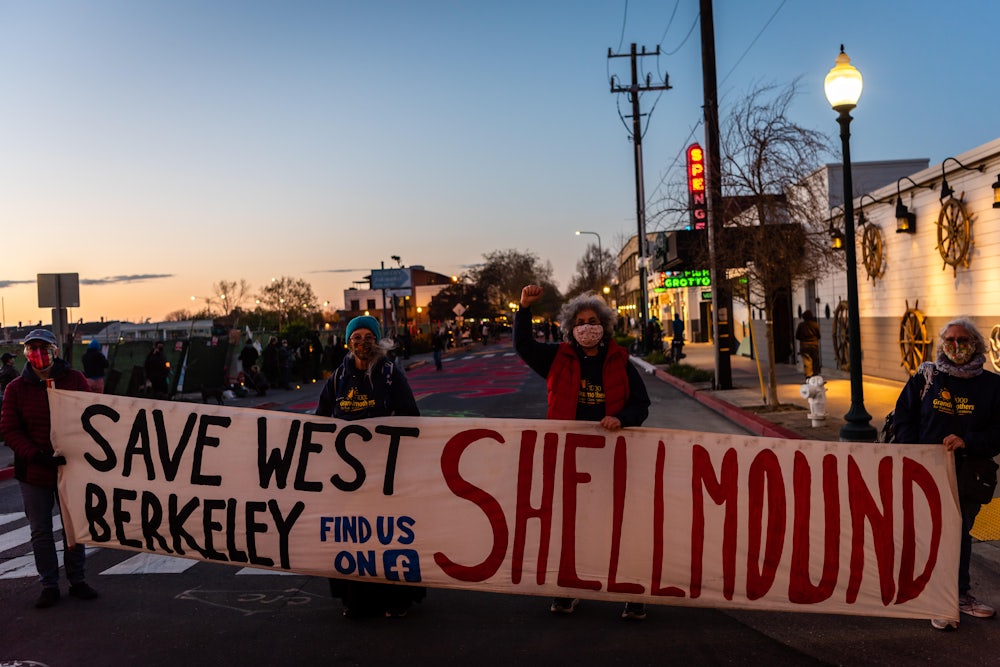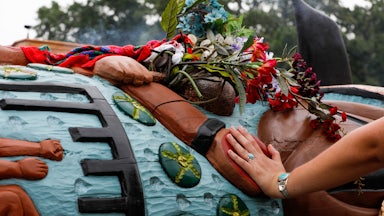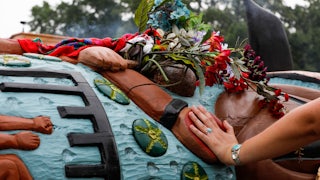Everyone agrees California has an affordable housing crisis. From 2012 to 2019, the average price for a home in the San Francisco Bay Area increased 88 percent. The number of people living without shelter there on any given night is 28,000; in the city of Los Angeles, in January 2020, it was over 41,000. A record number of Californians are leaving expensive metropolitan areas for the less temperate Central Valley, and many more are moving eastward to states like Texas or Nevada, where the cost of a house runs more like $200,000 to $400,000.
California’s approach to housing is threefold: providing shelter and temporary housing for people without homes, supplying subsidies for rent-burdened Californians, and building as much housing as possible as quickly as possible to put more units on the market. The last of these was the animus behind two new bills signed into law this fall allowing for denser construction in California’s cities and suburbs. The legislation joins previous efforts like State Bill 35, first introduced to the state legislature in 2017 and made law in January 2018. “CA is unaffordable for too many families. SB2-Atkins & SB35-Wiener accelerate new housing inventory to ease the crisis,” California Governor Gavin Newsom tweeted about the legislation and another related bill back in 2017, when he was lieutenant governor. “It streamlines the approval process for housing. It explicitly dictates less bureaucratic obstacles.”
But this less bureaucratic approval process for housing has greenlit further destruction of a sacred space known as the Shellmound, a 5,700-year-old Ohlone funerary and prayer site located in the Bay Area’s West Berkeley neighborhood. The space, at 1900 Fourth Street, is no longer a 20-foot-high mound adorned with shell pieces, abalone pendants, and other ritual items, as it was a century ago—it’s a parking lot. Cars parked on top of the Shellmound site, which is paved over and surrounded by a fence, look out onto a boutique strip mall of Madewell, Anthropologie, and Lululemon storefronts. Soon the lot, where Ohlone peoples still hold ceremonies and come to pray, will be transformed into a mixed-use apartment building, with 50 percent of the units marketed as “affordable” rentals—but lower-cost housing in one of the most expensive cities in the country is still high-cost housing. Half of the units will be reserved for tenants earning up to 80 percent of Berkeley’s median income, which for a single person is $73,120.
Ohlone land defenders and activist allies have resisted the proposal for building on the sacred land for years, but in late July the California Supreme Court ruled that, based on S.B. 35, Ruegg & Ellsworth and the Frank Spenger Company, which own the Shellmound site, have the right to desecrate it. More housing is needed, yes, but the fight over the Shellmound isn’t really about the severity of the housing crisis—260 new units made available years down the line won’t aid those suffering most acutely from houselessness and high rent. It is about the fact that the Shellmound, material from which was literally used in municipal construction projects to build Berkeley, is now being sacrificed in the name of progressive housing-first policy, and the fact that Native peoples, who are among those most likely to be rent-burdened and most likely to lack shelter nationwide, don’t have a say in what happens to Native land.
“Our sacred sites were never given up by our families—not legally, nor in theory,” the Confederated Villages of Lisjan said in a statement to the Mercury News in 2017. “They are not properties or parcel numbers that can be bought and sold. We did not stand in opposition when you developed other parts of our land. We do not get in the way when you put up apartment buildings or shopping malls. But where we draw the line is when you propose to dig up and desecrate the most sacred places where our ancestors are buried.”
The lot at 1900 Fourth Street has been vacant or undeveloped (in the eyes of real estate interests, if not community members) since 2000, when Berkeley declared the site a landmark, though Ohlone leaders fought for its sanctity and protection for many decades before that. The landmark designation doesn’t prevent construction on the site per se, but it added a few more hoops that held off quick development of the lot.
Corrina Gould, the spokesperson for the Confederated Villages of Lisjan, and one of the main advocates of saving and transforming the Shellmound site, presented an alternative vision for the site’s development to the City of Berkeley in 2017. The idea is to turn the sacred site into a space that all can enjoy by honoring the original peoples of the land and underscoring that, despite the state’s best efforts, Native people still live in the Bay Area and still steward these lands. Gould’s vision includes building a 40-foot-high mound that doubles as an educational center, blanketed in California poppies. There would be a dance facility for Ohlone ceremonies, native plants, and potentially, the restoration of Strawberry Creek, which used to run through the Ohlone village next to the Shellmound.
In 2017, a development company moved forward with its plan to purchase the land and build 260 units. The following year the legislature passed S.B. 35, and the developer adjusted the number of affordable units to hit the 50 percent mark required to fast-track the acquisition as dictated by the legislation. But then the developer dropped the project without explanation, relinquishing the rights back to the property owners, which then sued the City of Berkeley later that year for “violating” S.B. 35 by imposing barriers that slowed construction. In 2019, an Alameda County judge ruled in favor of the city and Shellmound defenders, saying that it was well within the municipality’s rights to take its time with approving a project attempting to build on protected lands. A Court of Appeals reversed that decision, and the state Supreme Court refused to hear arguments in the case, agreeing with the lower court’s decision and allowing the project to move forward in order to, as Newsom had put it, “ease the crisis.”
The Confederated Villages of Lisjan, one of many Ohlone tribes in what is now known as the East Bay, isn’t one of the 574 federally recognized tribes, meaning that the Lisjan Ohlone have no legal, treaty-protected claim to the Shellmound site—or any of the hundreds of other such shell-mound sites scattered across the Bay Area. And while the City of Berkeley’s landmark designation of the space might have helped to forestall any construction project, the state’s high court’s decision sets a dangerous precedent for Home Rule (which says that charter cities, like Berkeley, have agency to regulate municipal issues), paints any Indigenous person who attempts to protect sacred land as anti–affordable housing, and affirms that the aim of development supersedes protection of sacred land.
The appeals court’s decision, which the state Supreme Court upheld, extensively cited arguments provided in state legislation outlining the need for S.B. 35, which read, “The consequences of failing to effectively and aggressively confront this crisis are hurting millions of Californians, robbing future generations of the chance to call California home, stifling economic opportunities for workers and businesses, worsening poverty and homelessness, and undermining the state’s environmental and climate objectives.” There are no provisions in the legislation to protect sacred Native sites, though there are provisions protecting native plant species. But the same day the legislature approved S.B. 35, it also amended previous legislative code negating Home Rule in order to break ground quickly on new projects. That’s significant, given that the Confederated Villages of Lisjan don’t have a government-to-government relationship with California or the United States, meaning that the Ohlone tribes are reliant on solidarity and support from the city, which was also stripped of its power. A later bill, signed into law by the governor in September 2020, supposedly protects sacred spaces from S.B. 35, but it wasn’t enough to protect the Shellmound. It appears that the crisis of housing and the crisis of Native sovereignty are at odds, exemplified by a judgment that puts all Native-led land-defending efforts in jeopardy. As the U.C. Berkeley Department of Anthropology said in an amicus brief to the court, “The treatment of these shellmounds in the Court of Appeal Decision sets a precedent with potentially disastrous implications for the preservation of these historic structures, as in the present case.”
Paving over Ohlone land is analogous to paving over Ohlone people, a policy with roots in the creation of the United States and, later, in the repurposing of Mexican land to make California. Wars over land presuppose a war against the land’s people; California’s first governor, Peter Burnett, claimed in a 1851 speech that the “inevitable destiny” of the extermination of Indigenous people would continue “until the Indian race should become extinct.” The state soon approved laws creating Indian boarding schools, outlawing Indigenous languages, and allowing for the arrest of Indigenous people if police thought they were unemployed so that they could be sold as laborers. Until 1978, no Native person living in California could practice traditional religious and sacred ceremonies; freedom of religion applied solely to settlers. California’s fulfillment as a state required the subjugation of Native peoples, and tribal lands now account for 520,000 acres of California’s total land mass of 100 million acres. In 2019, Newsom offered a formal apology on behalf of California for its past wrongs to Native American peoples, saying that the government “commends and honors California Native Americans for persisting, carrying on cultural and linguistic traditions, and stewarding and protecting this land that we now share.”
Indigenous peoples have always been placed in diametric opposition to the project and progress of the U.S., while public education campaigns have tried to convince the American living that our dead were not all that bad—after all, most of us live on stolen land developed by these wayfaring settlers. It may seem a stretch to connect S.B. 35, in the twenty-first century, to earlier legal and colonial regimes imposed on Native peoples, such as relocation, assimilation, and termination (abolishing Native tribes and their sociopolitical power). But those laws made resisting a life driven by capital so impossible that Native peoples had no choice but to be absorbed into whiteness in cities or suffer financial impoverishment on reservations. There’s a specific history related to housing here, too: The Dawes Act and the Homestead Act incentivized individual land ownership and equated it with being civilized, destroying Native land and reservations in the process to the benefit of white Americans. Colonization was a housing crisis all on its own.
The rampant housing speculation known previously as westward expansion and currently as “development” has stripped Native peoples of affordable housing options. Today, California is home to the largest population of Native people in the country, yet Native and Indigenous people are some of the most economically disenfranchised of any ethnic group. The median income for a Native household nationwide is just under $40,000, with a poverty rate of as high as 33 percent. The homeownership rate for Native people is just over 50 percent, compared to nearly 75 percent for white Americans.
With the approval of the state’s judicial system for the Shellmound development, the next questions for the Ohlone people are when construction will begin and if they will still have access to the site. Berkeley Mayor Jesse Arreguín added another when the court decision came down: “How much more are we going to desecrate cultural sites and cultural heritage of our first people?”










